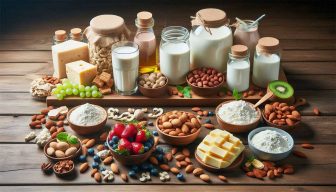Cow’s milk, a staple in many diets, undergoes a fascinating transformation to become that beloved tub of whey protein powder you see on the shelves. Have you ever wondered about the journey your whey protein takes from the udder to the container in your hands? Join us as we explore the intricate process of how this valuable protein source is carefully extracted, processed, and packaged for your consumption. Whether you’re an avid gym buff or just curious about where your supplements come from, this journey from cow to container will shed light on the fascinating world of whey protein production.
Key Takeaways:
- Whey Protein Production: Whey protein is a byproduct of cheese production and undergoes several filtration and purification steps to obtain the final product.
- Nutritional Benefits: Whey protein is a complete protein containing all vital amino acids and is easily absorbed by the body, making it an ideal supplement for muscle building and recovery.
- Versatility and Usage: Whey protein can be consumed in various forms such as shakes, bars, or added to recipes, making it a convenient and versatile source of protein for athletes and fitness enthusiasts.
- Sustainability: The production of whey protein contributes to reducing food waste by utilizing a byproduct of cheese production, promoting sustainability in the dairy industry.
- Quality Assurance: It is important to choose whey protein from reputable brands that undergo strict quality control measures to ensure purity, safety, and efficacy of the product.
Origins of Whey Protein
A byproduct of the cheese-making process, whey protein has a long history dating back to the days of ancient Greece. This high-quality protein is extracted from whey, the liquid remaining after milk has been curdled and strained during cheese production.

The Dairy Industry: Where it all Begins
The dairy industry plays a crucial role in the journey of whey protein. When milk is processed to make cheese, whey is separated from the solids (curds) through a series of filtration and separation processes. This leftover liquid, which was once considered a waste product, is now recognized for its nutritional benefits and is used to produce whey protein supplements.
The Role of Whey in Cheese Production
Origins. Another key point to note is that whey is not only a byproduct but also a crucial part of the cheese-making process. After the curds are formed and removed, the remaining liquid whey is rich in proteins, such as alpha-lactalbumin and beta-lactoglobulin, which are the building blocks of whey protein.
Harvesting Whey
Clearly, the journey of whey protein starts at the dairy farms where milk is processed into various products, including cheese and yogurt. During the cheese-making process, whey, a byproduct rich in protein and nutrients, is separated from the curds.
Collecting Whey from Dairy Farms
Farms collect the liquid whey by diverting it from the cheese-making vats into storage tanks. This whey is then carefully transported to processing facilities where it will undergo further filtration and purification to extract the valuable protein content.
Transporting Whey to Processing Facilities
Any excess whey that cannot be processed on-site at the dairy farms is transported in specially designed tankers to processing facilities. These tankers are equipped with temperature-controlled compartments to ensure the whey remains fresh during transit.
The whey collected from dairy farms is a valuable resource that is then taken to processing facilities to be turned into high-quality whey protein supplements for you to enjoy. The next steps involve separating the whey into its components and processing it into the final product.
Processing Whey
Now, let’s examine the fascinating journey whey protein undergoes during the processing stage before it reaches your container. This intricate process involves several steps to ensure the final product is pure, safe, and packed with nutritious goodness.
Pasteurization and Sanitization
An necessary step in processing whey protein is pasteurization and sanitization. This process involves heating the liquid whey to kill any harmful bacteria and pathogens, ensuring the safety and quality of the final product that you consume. By eliminating these contaminants, the whey protein becomes safer for consumption, giving you peace of mind knowing that it has gone through rigorous safety measures.
Microfiltration and Ultrafiltration
One of the key processes in whey protein production is microfiltration and ultrafiltration. These techniques involve passing the liquid whey through special filters that separate the protein from fats, lactose, and minerals. This filtration process helps concentrate the protein content, creating a purer form of whey protein powder that is rich in necessary amino acids, perfect for supporting your muscle recovery and growth. With microfiltration and ultrafiltration, you get a high-quality whey protein product that is low in fats and carbohydrates, making it an excellent choice for those looking to boost their protein intake without unnecessary added components.
Evaporation and Drying
With microfiltration complete, the next step in the process is evaporation and drying. The filtered liquid whey is evaporated to remove excess water, leaving behind a concentrated protein solution. This solution is then dried through methods like spray drying or freeze drying to form the final whey protein powder that you can easily mix into your shakes or recipes. Microfiltration and evaporation play a crucial role in creating a convenient and versatile whey protein product that you can enjoy in various ways, whether you prefer a quick shake after your workout or incorporating it into your favorite recipes for an added protein boost. Another important aspect of evaporation and drying is to ensure the preservation of the protein’s quality and nutritional value throughout the process, guaranteeing that you receive all the benefits whey protein has to offer in every serving.
Manufacturing Whey Protein Powder
All along the journey of turning liquid whey into the powdered form of whey protein that you are familiar with, there are several vital steps involved in the manufacturing process.
Spray Drying and Agglomeration
On the journey from liquid whey to whey protein powder, one crucial step is spray drying. In this process, the liquid whey is sprayed into a hot chamber. As the droplets fall, they lose moisture and become powder, which is then collected. This method helps in preserving the protein content and bioactivity of whey protein. Additionally, agglomeration is another process that follows spray drying, where the fine particles of whey protein powder are mixed and heated slightly to form larger agglomerates. These agglomerates improve the mixability and solubility of the final whey protein powder product.
Packaging and Quality Control
Agglomeration plays a vital role in enhancing the texture and mixability of whey protein powder. It helps in creating a more consistent and smoother powder that readily dissolves in your beverages. After the agglomeration process, the whey protein powder is carefully packaged to ensure its freshness and quality. The packaging process not only safeguards the product but also provides important information such as expiration dates, nutritional facts, and usage instructions.
The journey of whey protein, from the cow to the container in your hands, involves meticulous steps and processes to deliver a high-quality product that meets your nutritional needs. Whether it’s spray drying and agglomeration to preserve the protein content or packaging and quality control to ensure the product’s freshness and integrity, each step is crucial in delivering the whey protein powder you trust and rely on for your fitness goals.
The Science of Whey Protein
Protein Structure and Function
An vital component of whey protein is its unique protein structure, comprising a complete amino acid profile. These amino acids are the building blocks of proteins and play a vital role in numerous functions within the body, such as muscle repair and growth, immune system support, and enzyme production.
Amino Acid Profile and Bioavailability
Bioavailability refers to the proportion of a nutrient that is absorbed and utilized in the body. Whey protein boasts a high bioavailability score, meaning it is efficiently digested and its amino acids readily absorbed by the body. This factor makes whey protein an excellent choice for post-workout recovery or as a convenient way to increase your daily protein intake.
This high bioavailability is due to whey protein’s rich vital amino acid profile, including leucine, which is particularly crucial for muscle protein synthesis. This makes whey protein a popular choice among athletes and fitness enthusiasts looking to support muscle recovery and growth.
Research on Whey Protein’s Health Benefits
Functioning as a complete protein source, whey protein has been the subject of various research studies exploring its health benefits. From supporting weight management to promoting muscle integrity and aiding in immune function, whey protein continues to demonstrate its versatility and positive impact on overall health.
Understanding the science behind whey protein can empower you to make informed decisions about incorporating it into your diet, whether your goal is to enhance athletic performance, support muscle recovery, or simply maintain a balanced and nutritious eating regimen.
Applications of Whey Protein
Sports Nutrition and Fitness
Keep in mind that whey protein is a popular supplement among athletes and fitness enthusiasts for a good reason. One of the main benefits is its fast absorption rate, making it an excellent choice for post-workout recovery. Whey protein contains all necessary amino acids needed to support muscle growth and repair, helping you achieve your fitness goals more effectively.
Food Manufacturing and Product Development
Whey protein is a versatile ingredient that can be used in a variety of food products such as protein bars, shakes, and baked goods. With its high protein content and neutral flavor profile, whey protein can easily be incorporated into different recipes to boost their nutritional value. Food manufacturers often use whey protein to enhance the texture, taste, and nutritional profile of their products. Whey protein is a byproduct of cheese production, and its utilization in food manufacturing helps reduce waste while adding value to the final product. Whether you’re enjoying a protein-packed snack or a refreshing beverage, chances are whey protein plays a role in enhancing your culinary experience.
Pharmaceuticals and Cosmetics
Sports, fitness, and health supplements are not the only areas where whey protein can be beneficial. In the pharmaceutical and cosmetics industries, whey protein is valued for its potential skin-enhancing properties. For instance, whey protein may be used in skincare products for its moisturizing and anti-aging benefits, helping you maintain healthy and youthful-looking skin.
Summing up
Presently, you have journeyed through the elaborate process of how whey protein is made, from its humble beginnings as a byproduct of cheese production to becoming a popular supplement for athletes and fitness enthusiasts. You now understand the steps involved in turning liquid whey into a dried powder ready for packaging and consumption.
As you reflect on the journey of whey protein, you gain a deeper appreciation for the complexity and precision required to create this product. From the careful processing and filtration to the quality control measures in place, each stage plays a crucial role in ensuring you receive a high-quality product that supports your fitness goals. Remember the journey next time you mix up a whey protein shake, knowing that it started with a cow and ended up in your hands, ready to fuel your workouts and recovery.






